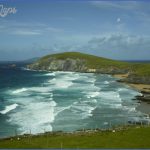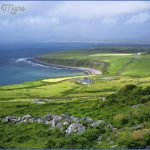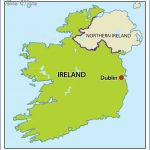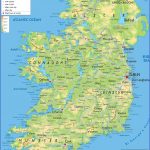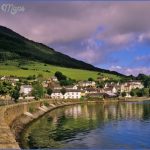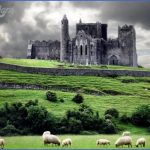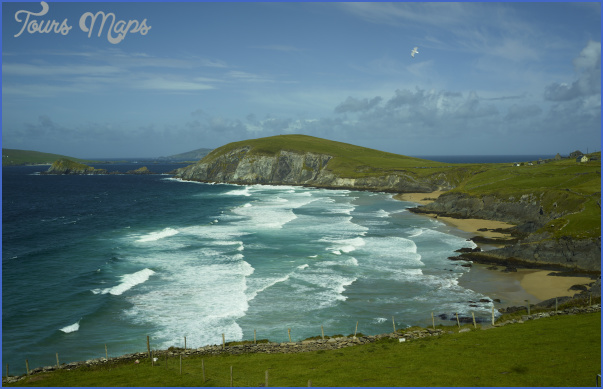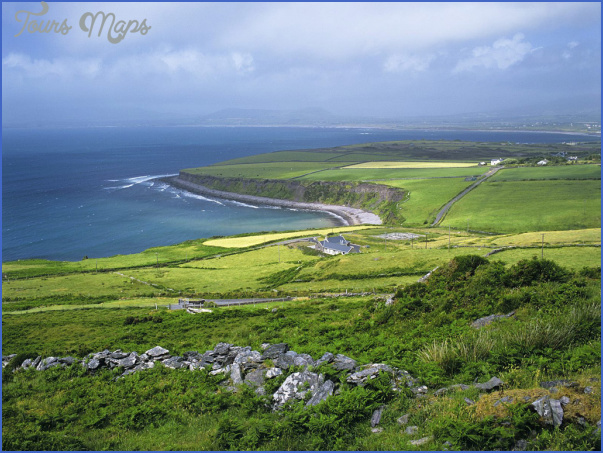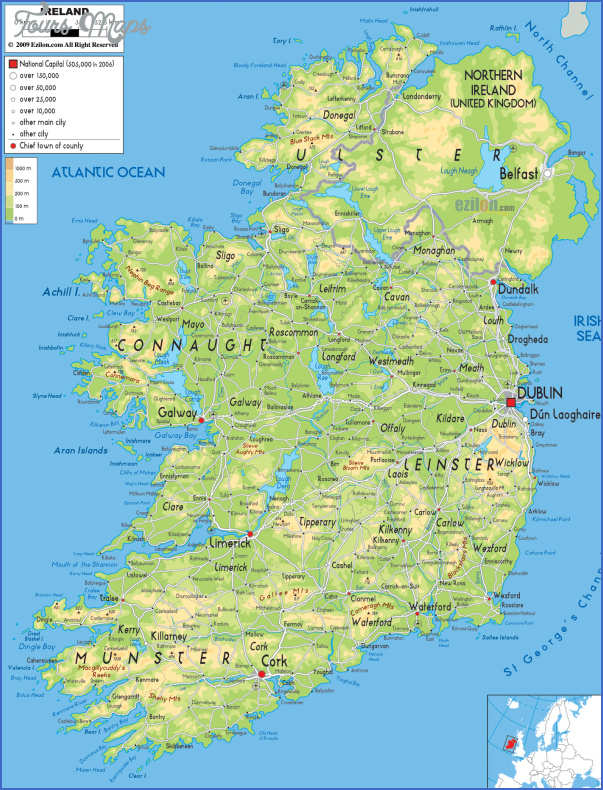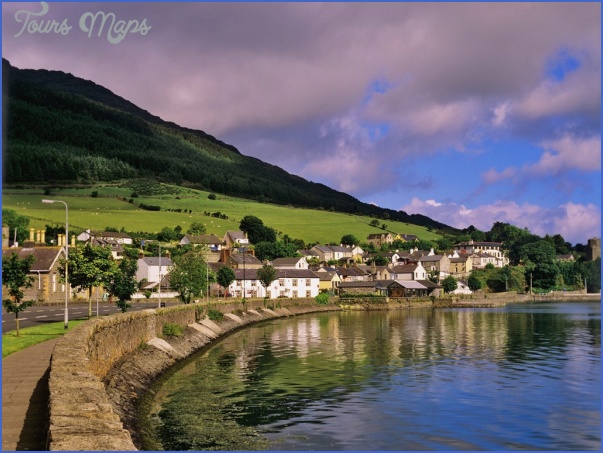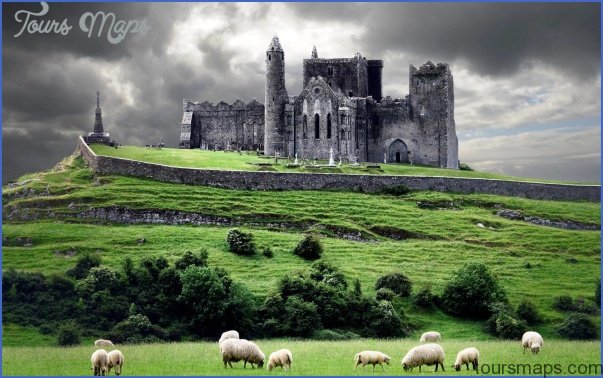Travelers who come to Ireland with their heads filled with poetic imagery will not be disappointed this largely agricultural and sparsely populated island still looks as it did when Celtic bards roamed the land. Windswept scenery is found all along the coast, and untouched mountain chains stretch across the interior bogland. The landscape is punctuated with pockets of civilization, ranging in size from one- street villages to large cities; Dublin and Belfast are cosmopolitan centers whose international populations greatly influence their immediate surroundings. Some fear this threatens the native culture, but the survival of traditional music, dance, and storytelling proves otherwise. The Irish language lives on in small, secluded areas known as gaeltachts, as well as on road signs, in national publications, and in a growing body of modem literary works. While non-violence usually prevails in Northern Ireland, recent negotiations hope to ensure peace for future generations. Although the Republic and Northern Ireland are grouped together in this chapter for geographical reasons, no political statement is intended.
LIFE AND TIMES HISTORY
EARLY CHRISTIANS AND VIKINGS (450-1200). Ireland was Christianized in a piecemeal fashion by a series of hopeful missionaries starting with St. Patrick in the 5th century. After the Dal Cais clan defeated the Vikings in the epic Battle of Clontarf, Ireland was divided between chieftains Rory O’Connor and Dermot MacMur- rough, who then fought for the crown between themselves. Dermot ill-advisedly sought the assistance of Richard de Clare, known popularly as Strongbow, who arrived in 1169 and cut a bloody swath through Leinster (eastern and southeastern
Strongbow married Dermot’s daughter Aoife after Dermot’s death in 1171 and seemed ready to proclaim an independent Norman kingdom in Ireland. Instead, the turncoat affirmed his loyalty to King Henry II and offered to govern Leinster on England’s behalf. Thus began English domination over Irish land.
FEUDALISM (1200-1641). The subsequent feudal period saw constant struggles between English lords of Gaelic and Norman descent. When Henry VIII created the Church of England, the Dublin Parliament passed the 1537 Irish Supremacy Act, which declared Henry head of the Protestant Church of Ireland and effectively made the island property of the Crown. In defiance of the monarchy, Hugh O’Neill, an Ulster earl, raised an army of thousands in open rebellion in the late 1590s, supported by Gaelic lords. Their forces were soon demolished, and the rebels left Ireland in 1607 in what is now known as the Flight of the Earls. The English took control of land, and parceled it out to Protestants.
PLANTATION AND CROMWELL (1641-1688). The English project of dispossessing Catholics of their land and planting Ireland with Protestants was most successful in Ulster, which became known as the Ulster Plantation. In response, the now landless Irish natives rebelled in 1641 under a loose-knit group of Gaelic-Irish leaders. In 1642 the rebels formed the Confederation of Kilkenny, an uneasy alliance of the Church and Irish and Old English lords. Negotiations between the Confederation and King Charles ended with Oliver Cromwell’s victory in England and his arrival in Ireland. Cromwell’s army destroyed everything it came across, divvying up confiscated lands among Protestants and soldiers. By 1660, the vast majority of Irish land was owned, maintained, and policed by Protestant immigrants.
THE PROTESTANT ASCENDANCY (1688-1798). Thirty years after the English Civil War, English political disruption again resulted in Irish bloodshed. Deposed Catholic monarch James II, driven from England by the Glorious Revolution of 1688, came to Ireland to gather military support and reclaim his throne. A war between James and William of Orange, the new Protestant king, ended on July 12, 1690 at the Battle of the Boyne with James’s defeat and exile. The term Ascendancy was coined to describe the social elite whose distinction depended upon Anglicanism. Trinity College was the quintessential institution of the Ascended Protestants.
UNION AND THE FAMINE (1798-1847). The 1801 Act of Union dissolved the Dublin Parliament and created The United Kingdom of Great Britain and Ireland; the Church of Ireland was subsumed by the United Church of England and Ireland. During this time, the potato was the wonder-crop of the rapidly growing Irish population. The potato blight of the Great Famine (1847-1851) killed an estimated two to three million people; a million more emigrated. In short, close to half of Ireland’s population either died or fled from the blight. In 1858, James Stephens founded the Irish Republican Brotherhood (IRB), commonly known as the Fenians, a secret society aimed at the violent removal of the British.
CULTURAL NATIONALISM (1870-1914). In 1870, Isaac Butt founded the Irish Home Rule Party, bent on securing autonomous rule for Ireland. Meanwhile, various groups tried to revive an essential Gaelic culture, unpolluted by foreign influence; Arthur Griffin began a fledgling movement by the name of Sinn Fein (SHIN FAYN; Ourselves Alone). As the Home Rule movement grew, so did resistance to it. Between 1910 and 1913, thousands of Northern Protestants opposing Home Rule joined a quasi-militia named the Ulster Volunteer Force (UVF). Nationalists led by Eoin MacNeill responded by creating the Irish Volunteers.
THE EASTER RISING (1914-1919). During World War I, British Prime Minister Henry Asquith passed a Home Rule Bill on the condition that Irishmen would fight for the British army. The Irish Volunteers that remained behind were led by Mac- Neill, who did not know that Fenian leaders were plotting to receive a shipment of German arms for use in a nationwide revolt on Easter Sunday, 1916. Although the arms arrived a day too early and were never picked up, Fenian leaders continued to muster support from the Volunteers. On Monday, April 24, about 1000 rebels seized the Dublin General Post Office on O’Connell St. holding on through five days of fighting. Fifteen ringleaders then received the death sentence, causing the public to grow increasingly sympathetic to the rebels and anti-British. In 1917, the Volunteers reorganized under Fenian bigwig Michael Collins. Collins brought the Volunteers to Sinn Fein, and Eamon de Valera became the party president.
INDEPENDENCE AND CIVIL WAR (1919-1922). Extremist Irish Volunteers became known as the Irish Republican Army (IRA). The IRA functioned as the military arm of Sinn Fein, winning the War of Independence (1919-1921) against the British. Hurried negotiations produced the Anglo-Irish Treaty, which created a 26- county Irish Free State, while still recognizing British rule over the northern counties. Sinn Fein, the IRA, and the population split on whether to accept the treaty. Collins said yes; de Valera said no. When the representative parliament voted in favor, de Valera resigned from the presidency and Arthur Griffith assumed the posi-tion. The capable Griffith and Collins government began the business of setting up a nation. A portion of the IRA, led by General Rory O’Connor, opposed the treaty. O’Connor’s Republicans occupied the Four Courts in Dublin, took a pro-treaty Army general hostage, and were attacked by the forces of Collins’s government. Two years of civil war followed. The pro-treaty government won, but Griffith died from the strain of the struggle and Collins was assassinated.
THE DE VALERA ERA (1922-1960). In 1927 de Valera broke with Sinn Fein and the IRA and founded his own political party, Fianna Fill. The party won the 1932 election, and de Valera held power for much of the next 20 years. In 1937, de Valera and the voters approved the Irish Constitution. It declared the state’s name to be Eire, and established the country’s legislative structure, consisting of two chambers with five-year terms. Ireland stayed neutral during World War II, despite German air raids on Dublin. Many Irish citizens identified with the Allies, and approximately 50,000 served in the British army. In 1948, the Fine Gael government under John Costello had the honor of officially proclaiming The Republic of Ireland free, supposedly ending British Commonwealth membership. Britain recognized the Republic in 1949 but declared that the UK would maintain control over Ulster until the Parliament of Northern Ireland consented to join the Republic.
RECENT HISTORY (1960-1990). Ireland’s post-war boom didn’t arrive until the early 1960s, and economic mismanagement and poor governmental policies kept it short. In an effort to revitalize the nation, the Republic entered the European Economic Community, now the European Union (EU), in 1973. EU funds proved crucial to helping Ireland out of a severe mid-80s recession and reducing its dependence on the UK. In 1990, the Republic broke social and political ground when it elected its first female president, Mary Robinson.
IRELAND Photo Gallery
Maybe You Like Them Too
- Explore Sasbach, Germany with our Interactive Map
- Explore Nevestino, Bulgaria with this Detailed Map
- Explore Pulau Sebang Malaysia with this Detailed Map
- Explore Southgate, Michigan with this detailed map
- Explore Les Accates, France with this Detailed Map

